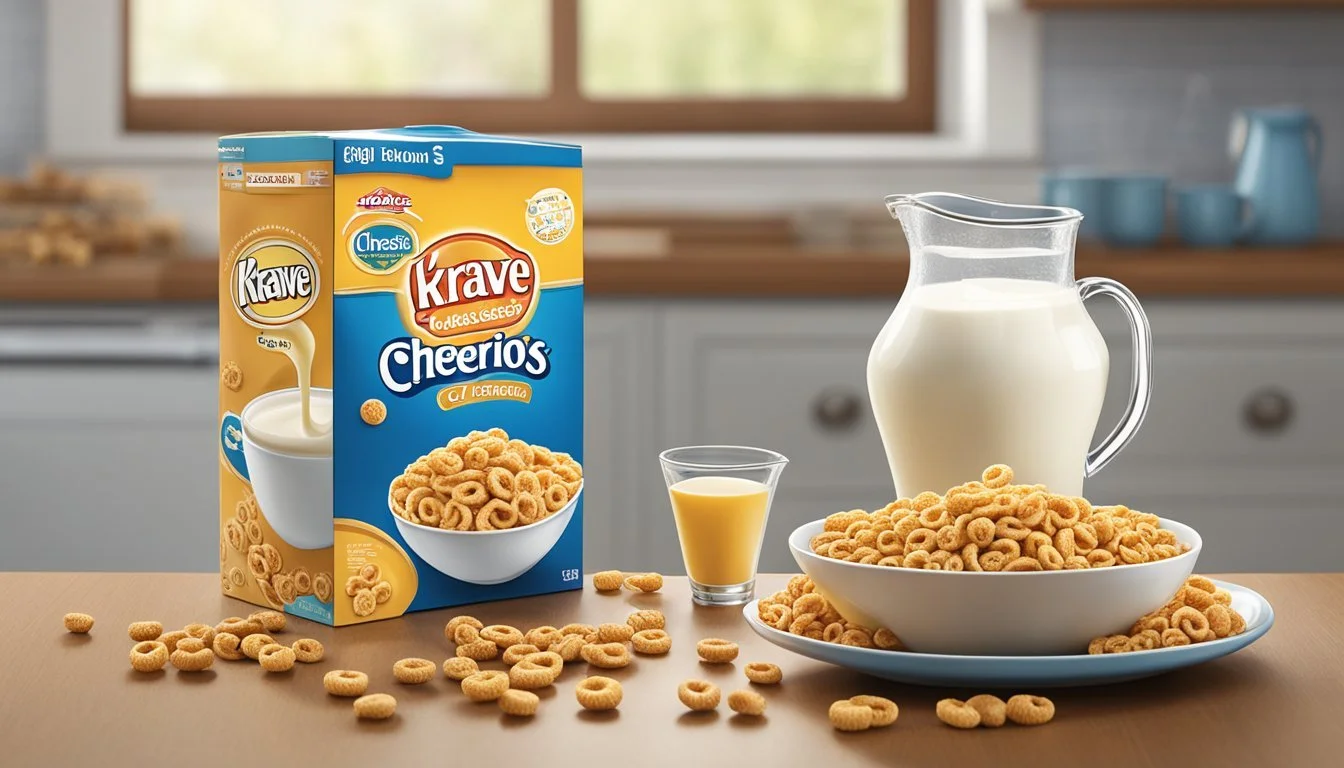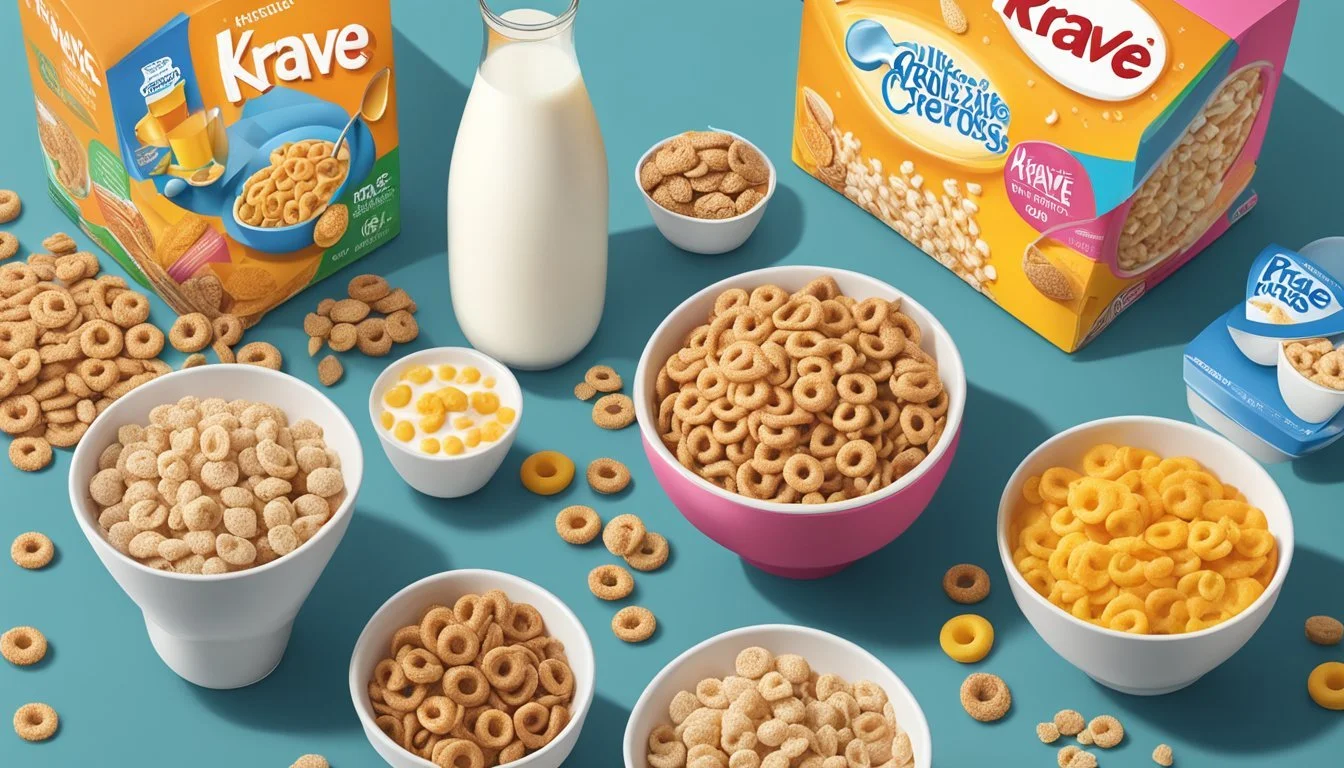Cheerios vs Krave
Nutritional Comparison and Taste Test
This Article is Part of Our Breakfast Cereal Guide with Details on Cheerios Nutrition and Krave Nutrition
When it comes to breakfast cereals, Cheerios and Krave are popular choices with distinct qualities that cater to different preferences. Cheerios, known for their simple, wholesome ingredients, offer a heart-healthy option with whole grain oats and lower sugar content. This makes them an excellent choice for those mindful of their nutritional intake.
Krave, on the other hand, appeals to chocolate lovers seeking a more indulgent breakfast experience. With its chocolate-filled centers, Krave provides a sweet start to the day that can also serve as a satisfying snack. While it may not boast the same nutritional benefits as Cheerios, Krave's irresistible taste and unique texture make it a favorite among those with a sweet tooth.
Both cereals bring something unique to the breakfast table. Cheerios offer a health-conscious option, perfect for starting the day on a nutritious note. Krave delivers a delightful, chocolatey experience, ideal for those looking to treat themselves.
Overview of Cheerios and Krave
Cheerios and Krave are two popular cereals with distinct appeal and unique qualities. Specifically, they cater to different tastes and nutritional preferences, each excelling in their own niches.
History and Brand Profiles
General Mills Cheerios was first introduced in 1941. Known for being heart-healthy, it has grown into one of the best-selling cereals in the USA. Cheerios is primarily recognized for its distinctive "O" shape and whole-grain oats as its main ingredient.
Kellogg's Krave is a relatively newer entry, launched in 2012. It stands out for its sweet, chocolate-filled centers, offering a different experience from more traditional cereals. Designed for chocolate lovers, Krave provides a dessert-like quality to breakfast or snack time.
Product Varieties
Cheerios offers a broad range of flavors and types. These include:
Original Cheerios
Honey Nut Cheerios
Multigrain Cheerios
Frosted Cheerios
Each variety maintains a focus on whole grains and low sugar content, emphasizing health benefits.
Krave, produced by Kellogg's, focuses on indulgent flavors. The primary varieties include:
Chocolate Krave
Double Chocolate Krave
Both versions feature a crunchy outer shell and a soft chocolate interior, delivering a treat-like experience.
Target Audience and Marketing
Cheerios primarily targets health-conscious families. Marketing often highlights its whole grain content, low sugar, and benefits for heart health. Campaigns frequently emphasize Cheerios as a healthy choice for children and adults alike.
Krave, conversely, aims at a younger demographic, including teenagers and young adults. Marketing strategies often highlight the chocolate flavor and fun, indulgent eating experience. Kellogg's positions Krave as not just a breakfast cereal but also a versatile snack.
Cheerios appeals to those seeking nutrition in their daily diet, while Krave targets those looking for a sweeter, treat-like cereal option.
Nutritional Comparison
A balanced assessment of Cheerios and Krave takes into consideration the calories, sugar, fiber, protein, whole grains, as well as the vitamins and minerals provided in each serving.
Caloric Content Analysis
Cheerios offer a lower calorie count per serving compared to Krave. Specifically, a typical serving size (1 cup or 28 grams) of Cheerios contains about 100 calories.
In contrast, Krave, which provides a more indulgent taste profile, has approximately 120 calories per serving (1 cup or 30 grams). For those monitoring calorie intake, Cheerios might be the preferable choice.
Sugar Content and Health Implications
When it comes to sugar content, Cheerios outshine Krave. A serving of Cheerios contains around 1 gram of sugar.
On the other hand, Krave, being a chocolate-flavored cereal, includes about 11 grams of sugar per serving. Higher sugar intake can have adverse health effects, so for a lower sugar option, Cheerios is advisable.
Protein, Fiber, and Whole Grains Contributions
Cheerios are a good source of both protein and fiber, with 3 grams of protein and 3 grams of fiber per serving. Additionally, Cheerios are made from whole grains, providing an important contribution to daily whole grain intake.
Krave contains 2 grams of protein and 1 gram of fiber per serving. Whole grains are present but are not the primary ingredient, making Cheerios the better choice for fiber and whole grain content.
Vitamins and Minerals Profile
Cheerios are fortified with essential vitamins and minerals, including significant amounts of Vitamin D, B vitamins, iron, and calcium. This makes them a robust option for a nutrient-dense breakfast.
Krave also provides some vitamins and minerals, but in lower quantities compared to Cheerios. Specifically, Cheerios' vitamin and mineral content support better overall nutrition, contributing positively to a balanced diet.
By analyzing the caloric content, sugar levels, protein, fiber, whole grains, and vitamins and minerals, it becomes clear that while Krave offers a more indulgent breakfast experience, Cheerios present a healthier option for daily consumption.
Taste and Texture Experience
Cheerios and Krave each offer distinct taste and texture experiences, appealing to different preferences. This section breaks down their flavor profiles, consistency and sogginess, and milk interaction to highlight what differentiates these popular cereals.
Flavor Profiles
Cheerios are known for their mild, lightly sweetened taste with variants like Honey Nut and Apple Cinnamon that add dimensions. The base flavor is often subtle, allowing additions like fruits or nuts to shine. Honey Nut Cheerios, for example, combines slight nutty undertones with a sweet honey glaze, while the Plain variant offers a straightforward oat flavor.
Krave, on the other hand, caters to chocolate lovers with its rich and intense chocolate filling encased in a multigrain shell. The chocolate flavor is prominent, making each bite indulgent and dessert-like. This makes Krave a heavier and more satisfying option for those craving a chocolate cereal experience.
Consistency and Sogginess
The consistency of Cheerios remains relatively stable in milk, retaining a good crunch for several minutes. Honey Nut Cheerios, in particular, have a layered texture with a sweet, honey-coated exterior that adds a slight resistance to milk absorption. They soften gradually, allowing for a more extended crunchy experience.
Krave's texture is initially crunchy because of its thick, multigrain outer shell. The cereal's center is soft and creamy due to the chocolate filling, which contrasts with the outer shell. However, Krave tends to become soggy more quickly than Cheerios when exposed to milk, especially if not consumed immediately.
Milk Interaction
Cheerios and milk create a balanced combination. The cereal absorbs milk slowly, which allows the flavors to meld seamlessly without becoming overly mushy. The mildness of Cheerios allows the milk to take on a sweet, subtly nutty flavor, which can be quite pleasant.
Krave's interaction with milk is more intense due to the chocolate filling. As the cereal absorbs milk, it releases chocolate, creating a rich, flavored milk that's akin to drinking chocolate milk. This can be a delightful experience for chocolate cereal enthusiasts but may be overpowering for some, especially if they prefer less rich breakfast options.
Versatility in Consumption
Cheerios and Krave offer flexibility in how they can be consumed. These cereals appeal to different preferences and can be integrated into various meals beyond a traditional breakfast.
As a Standalone Snack
Cheerios serve as a healthy breakfast and a convenient dry snack. With low calories per serving and heart-healthy soluble fiber, they are ideal for those looking to manage weight. Cheerios can be easily packed for on-the-go consumption, making them popular among health-conscious individuals.
On the other hand, Krave provides a richer, more indulgent option. While not typically a diet food, its chocolate-filled pieces make it a satisfying snack for those looking to curb a sweet tooth. Though higher in sugar, it still offers the practicality of being consumed dry without additional preparation.
Complementary Foods and Recipes
Cheerios' neutral flavor simplifies their integration into various dishes. They can be added to smoothies for an extra crunch or used in salads to enhance texture. Many enjoy them as part of homemade trail mixes or as a coating for baked goods, lending versatility in both savory and sweet dishes.
Krave, with its dessert-like profile, pairs well with yogurt or can be incorporated into desserts such as parfaits and ice cream toppings. The cereal can also be a decadent addition to milkshakes. Although less versatile in savory recipes, it remains a popular choice for breakfast and snacking alike.
By catering to different dietary needs and taste preferences, both cereals demonstrate a broad range of uses that extend beyond the breakfast table.
Consumer Preferences and Trends
Cheerios and Krave have distinct consumer bases influenced by various trends and preferences. These preferences are shaped by factors such as sales data, social media, nostalgia, and expert dietary recommendations.
Market Popularity and Sales Data
Cheerios remains highly popular in the market, with General Mills reporting that it is the best-selling cereal in America. Honey Nut Cheerios ranks third, contributing significantly to over $435 million in annual sales. Data indicates that on average, Cheerios is consumed 1.13 times per year.
Krave, on the other hand, appeals to a niche audience, often younger consumers seeking indulgent cereals. While Krave may not match Cheerios' overall sales volume, it remains a competitive choice within its market segment.
Social Media Influence and Nostalgia
Social media platforms spotlight both Cheerios and Krave through user-generated content that underscores personal preferences and experiences. Cheerios often benefits from nostalgia, with many adults recalling it as a staple of their childhood breakfasts. This nostalgic appeal fuels its continued popularity among older generations.
Krave's social media presence is marked by its novelty. Influencers highlight its unique flavor combinations, appealing particularly to a younger audience looking for something different in their breakfast routine. The visual appeal of Krave's marketing also captures attention online, further driving its niche popularity.
Expert Opinions and Dietary Recommendations
Registered dietitians frequently recommend Cheerios as part of a healthy diet, emphasizing its whole grain content and low sugar levels. It is often highlighted as a heart-healthy option suitable for various age groups, making it a practical choice for budget-conscious families seeking nutritious breakfast options.
Krave, with its chocolaty filling, is less commonly recommended by dietary experts as a healthy cereal option. Its higher sugar content and indulgent nature make it more of a treat than a daily breakfast staple. However, it can fit into an overall balanced diet when consumed in moderation, providing a fun and flavorful choice for those seeking variety.
Environmental and Economic Impact
Examining the environmental and economic impact of Cheerios and Krave reveals important distinctions in production sustainability and pricing.
Production and Sustainability
Cheerios, produced by General Mills, has made significant strides in addressing climate change and sustainability. The company focuses on reducing greenhouse gas emissions and sourcing ingredients sustainably. Their commitment includes using organic oats and other natural ingredients to minimize the carbon footprint.
On the other hand, Krave is manufactured by Kellogg's, a company also invested in sustainable practices. They aim to source 100% of their cereals from sustainable farms by 2030. Despite these efforts, the complexity of Krave's ingredients, including chocolate, may involve higher environmental costs compared to Cheerios.
Both brands participate in broader sustainability initiatives. These efforts make them more attractive to consumers seeking sustainable breakfast options.
Price Point and Consumer Value
Cheerios and Krave differ not just in environmental practices but also in their pricing. Cheerios is generally considered a budget-friendly option, with prices reflecting its simpler ingredient list. General Mills aims to offer value without compromising on nutritional quality, making Cheerios a staple in many households.
Krave, with its chocolatey components, often comes at a higher price point due to the additional ingredients and production costs. This cereal is marketed as a more indulgent option, appealing to those willing to spend a bit more for a richer breakfast experience.
In terms of consumer value, Cheerios offers substantial nutritional benefits at a lower cost. Krave, while pricier, provides a different flavor profile that caters to those prioritizing taste. Both cereals manage to carve out their niche in the breakfast aisle, appealing to varied consumer priorities and budgets.
Conclusion
When comparing Cheerios to Krave, the distinctions become apparent in various aspects. Both cereals cater to different preferences and dietary goals.
Cheerios is often favored for those seeking a healthy breakfast option. It boasts lower sugar content and is rich in complex carbohydrates. This makes it suitable for individuals aiming to maintain balanced blood sugar levels.
Krave, on the other hand, is aimed at those who enjoy a sweeter and more indulgent cereal experience. The chocolaty flavor and texture make it appealing as both a breakfast option and a snack.
Nutritional information:
Cheerios: Lower in sugar, higher in fiber, 17.0 grams of complex carbohydrates per serving.
Krave: Higher in sugar, richly chocolaty, offers a unique texture.
The choice between these two cereals depends largely on individual dietary needs and taste preferences. While Cheerios aligns well with a balanced and health-conscious diet, Krave provides a delightful option for those who prioritize taste and sensory enjoyment.
Incorporating either cereal into one's daily routine can be beneficial, depending on what one seeks in a breakfast cereal. It's important to read and understand nutritional labels to make an informed choice.







